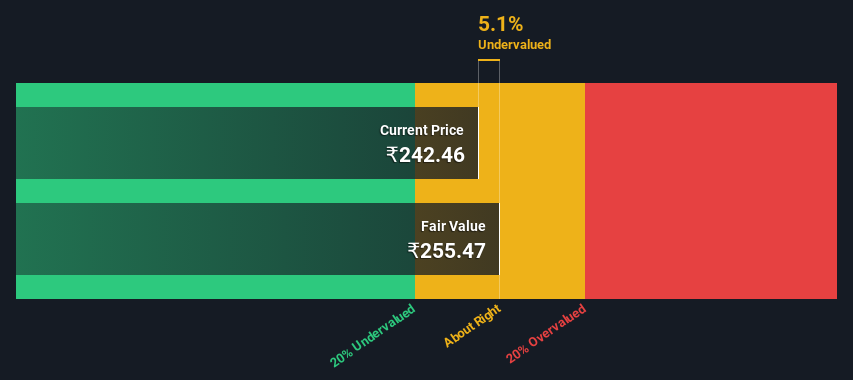- India
- /
- Hospitality
- /
- NSEI:KAMATHOTEL
Calculating The Fair Value Of Kamat Hotels (India) Limited (NSE:KAMATHOTEL)

Key Insights
- The projected fair value for Kamat Hotels (India) is ₹255 based on 2 Stage Free Cash Flow to Equity
- With ₹242 share price, Kamat Hotels (India) appears to be trading close to its estimated fair value
- The average premium for Kamat Hotels (India)'s competitorsis currently 290%
Today we'll do a simple run through of a valuation method used to estimate the attractiveness of Kamat Hotels (India) Limited (NSE:KAMATHOTEL) as an investment opportunity by estimating the company's future cash flows and discounting them to their present value. We will use the Discounted Cash Flow (DCF) model on this occasion. Don't get put off by the jargon, the math behind it is actually quite straightforward.
Companies can be valued in a lot of ways, so we would point out that a DCF is not perfect for every situation. If you still have some burning questions about this type of valuation, take a look at the Simply Wall St analysis model.
View our latest analysis for Kamat Hotels (India)
What's The Estimated Valuation?
We're using the 2-stage growth model, which simply means we take in account two stages of company's growth. In the initial period the company may have a higher growth rate and the second stage is usually assumed to have a stable growth rate. To start off with, we need to estimate the next ten years of cash flows. Seeing as no analyst estimates of free cash flow are available to us, we have extrapolate the previous free cash flow (FCF) from the company's last reported value. We assume companies with shrinking free cash flow will slow their rate of shrinkage, and that companies with growing free cash flow will see their growth rate slow, over this period. We do this to reflect that growth tends to slow more in the early years than it does in later years.
Generally we assume that a dollar today is more valuable than a dollar in the future, so we need to discount the sum of these future cash flows to arrive at a present value estimate:
10-year free cash flow (FCF) forecast
| 2025 | 2026 | 2027 | 2028 | 2029 | 2030 | 2031 | 2032 | 2033 | 2034 | |
| Levered FCF (₹, Millions) | ₹740.7m | ₹756.4m | ₹782.8m | ₹817.6m | ₹859.6m | ₹907.8m | ₹961.7m | ₹1.02b | ₹1.09b | ₹1.16b |
| Growth Rate Estimate Source | Est @ 0.14% | Est @ 2.11% | Est @ 3.49% | Est @ 4.46% | Est @ 5.13% | Est @ 5.61% | Est @ 5.94% | Est @ 6.17% | Est @ 6.33% | Est @ 6.44% |
| Present Value (₹, Millions) Discounted @ 16% | ₹641 | ₹567 | ₹508 | ₹459 | ₹418 | ₹382 | ₹350 | ₹322 | ₹297 | ₹273 |
("Est" = FCF growth rate estimated by Simply Wall St)
Present Value of 10-year Cash Flow (PVCF) = ₹4.2b
We now need to calculate the Terminal Value, which accounts for all the future cash flows after this ten year period. For a number of reasons a very conservative growth rate is used that cannot exceed that of a country's GDP growth. In this case we have used the 5-year average of the 10-year government bond yield (6.7%) to estimate future growth. In the same way as with the 10-year 'growth' period, we discount future cash flows to today's value, using a cost of equity of 16%.
Terminal Value (TV)= FCF2034 × (1 + g) ÷ (r – g) = ₹1.2b× (1 + 6.7%) ÷ (16%– 6.7%) = ₹14b
Present Value of Terminal Value (PVTV)= TV / (1 + r)10= ₹14b÷ ( 1 + 16%)10= ₹3.3b
The total value is the sum of cash flows for the next ten years plus the discounted terminal value, which results in the Total Equity Value, which in this case is ₹7.5b. In the final step we divide the equity value by the number of shares outstanding. Compared to the current share price of ₹242, the company appears about fair value at a 5.1% discount to where the stock price trades currently. Valuations are imprecise instruments though, rather like a telescope - move a few degrees and end up in a different galaxy. Do keep this in mind.

The Assumptions
The calculation above is very dependent on two assumptions. The first is the discount rate and the other is the cash flows. You don't have to agree with these inputs, I recommend redoing the calculations yourself and playing with them. The DCF also does not consider the possible cyclicality of an industry, or a company's future capital requirements, so it does not give a full picture of a company's potential performance. Given that we are looking at Kamat Hotels (India) as potential shareholders, the cost of equity is used as the discount rate, rather than the cost of capital (or weighted average cost of capital, WACC) which accounts for debt. In this calculation we've used 16%, which is based on a levered beta of 1.294. Beta is a measure of a stock's volatility, compared to the market as a whole. We get our beta from the industry average beta of globally comparable companies, with an imposed limit between 0.8 and 2.0, which is a reasonable range for a stable business.
SWOT Analysis for Kamat Hotels (India)
- Debt is well covered by cash flow.
- Earnings declined over the past year.
- Interest payments on debt are not well covered.
- Shareholders have been diluted in the past year.
- Current share price is below our estimate of fair value.
- Lack of analyst coverage makes it difficult to determine KAMATHOTEL's earnings prospects.
- No apparent threats visible for KAMATHOTEL.
Moving On:
Whilst important, the DCF calculation ideally won't be the sole piece of analysis you scrutinize for a company. DCF models are not the be-all and end-all of investment valuation. Instead the best use for a DCF model is to test certain assumptions and theories to see if they would lead to the company being undervalued or overvalued. For instance, if the terminal value growth rate is adjusted slightly, it can dramatically alter the overall result. For Kamat Hotels (India), there are three further elements you should further research:
- Risks: Take risks, for example - Kamat Hotels (India) has 5 warning signs (and 1 which makes us a bit uncomfortable) we think you should know about.
- Other High Quality Alternatives: Do you like a good all-rounder? Explore our interactive list of high quality stocks to get an idea of what else is out there you may be missing!
- Other Environmentally-Friendly Companies: Concerned about the environment and think consumers will buy eco-friendly products more and more? Browse through our interactive list of companies that are thinking about a greener future to discover some stocks you may not have thought of!
PS. Simply Wall St updates its DCF calculation for every Indian stock every day, so if you want to find the intrinsic value of any other stock just search here.
Valuation is complex, but we're here to simplify it.
Discover if Kamat Hotels (India) might be undervalued or overvalued with our detailed analysis, featuring fair value estimates, potential risks, dividends, insider trades, and its financial condition.
Access Free AnalysisHave feedback on this article? Concerned about the content? Get in touch with us directly. Alternatively, email editorial-team (at) simplywallst.com.
This article by Simply Wall St is general in nature. We provide commentary based on historical data and analyst forecasts only using an unbiased methodology and our articles are not intended to be financial advice. It does not constitute a recommendation to buy or sell any stock, and does not take account of your objectives, or your financial situation. We aim to bring you long-term focused analysis driven by fundamental data. Note that our analysis may not factor in the latest price-sensitive company announcements or qualitative material. Simply Wall St has no position in any stocks mentioned.
About NSEI:KAMATHOTEL
Moderate and good value.
Similar Companies
Market Insights
Community Narratives




